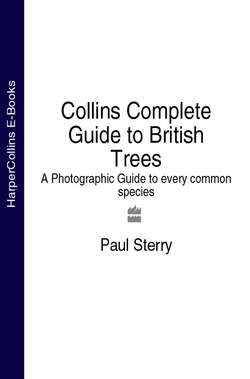Читать книгу Collins Complete Guide to British Trees: A Photographic Guide to every common species - Paul Sterry - Страница 7
ОглавлениеHOW TO USE THIS BOOK
The book has been designed so that the text and photographs for each species are on facing pages. A system of labelling clearly identifies each tree or shrub. The text complements the information conveyed by the photographs. By and large, the order in which species appear in the main section of the book roughly follows standard botanical classification. However, because parts of the field are in a state of flux, the order may differ slightly from that found in other guides, past, present or future.
SPECIES DESCRIPTIONS
At the start of each species description the most commonly used and current English name is given. My primary source of reference for this, and for scientific names, has been Clive Stace’s New Flora of the British Isles. Essentially this covers native and widely naturalised British species. For non-native garden trees and shrubs I have followed the naming employed by Owen Johnson in Collins’ Tree Guide.
The English name of each plant is followed by its scientific name, which comprises the genus name followed by the specific name. In a few instances, where this is pertinent, reference is made (either in the species heading or in the main body of the text) to a further subdivision: subspecies. Some cultivated trees and shrubs are known best, or sometimes exclusively, by their cultivar name, so where this helps with recognition I have included it; some hybrid trees and shrubs are now known only by their horticultural names.
The text has been written in as concise a manner as possible. Each description begins with a summary of the tree or shrub. To avoid potential ambiguities, the following subheadings break up the rest of each species description: BARK; BRANCHES (occasionally SHOOTS); LEAVES; REPRODUCTIVE PARTS; STATUS AND DISTRIBUTION; COMMENTS. Not all these headings are used for every species. Within the sections dealing with plant parts, colour, shape and size are described; these tend to be more constant, and hence are more useful for identification, than the overall size of the tree or shrub.
MAPS
The maps provide invaluable information about the distribution and occurrence of species in the region, but obviously they are only relevant in the case of native species and widely naturalised ones. Magenta has been used to represent the range of native species while cyan denotes the occurrence of naturalised alien trees or shrubs; the intensity of the colour gives an indication of a species’ abundance in a given area. In compiling the maps, I have made reference to a number of sources, including An Atlas of the Wild Flowers of Britain and Northern Europe, various county floras, the New Atlas of the British and Irish Flora and my own notes. The maps represent the current ranges of trees and shrubs in the region in general terms. Please bear in mind that, given the size of the maps, small and isolated populations will not necessarily be featured. Furthermore, the ranges of many species (particularly invasive introduced species and declining native trees and shrubs) are likely to change as the years go by.
Map coloration helps distinguish between the native and introduced distributions of species such as the Scots Pine.
PHOTOGRAPHS
Great care has gone into the selection of photographs for this book and in many cases the images have been taken specifically for this project. Preference was given to photographs that serve both to illustrate key identification features of a species and to emphasise its beauty. In many instances, smaller inset photographs illustrate features useful for identification that are not shown clearly by the main image.
